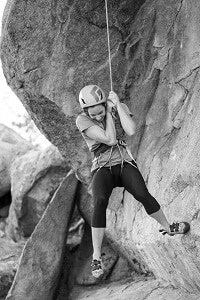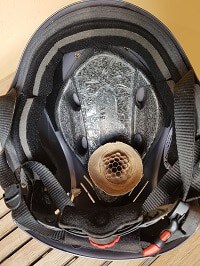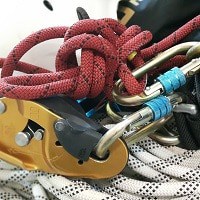Disclosure: Links marked with * are Affiliate Links. As an Amazon Associate, I earn from qualifying purchases if you decide to make a purchase through these links – at no cost for you!
Climbing equipment is expensive. With the right care, inspection, storage and transport, you can achieve the maximum lifespan of your equipment.
Every part of your climbing equipment undergoes a rigorous testing process to ensure that it serves its purpose in an emergency and that you can rely on it 100 percent. In order to maintain reliability for a long time, this article contains the most important tips for the care and maintenance of your climbing equipment.
Fundamentals
There are a few universal rules and tips you should follow to protect your equipment. They may sound stupid, but they are a frequent reason why climbing equipment has to be disposed of. Pay particular attention to this when it comes to safety equipment:
- Don’t leave your equipment just lying around – someone could step on it, it could get dirty, etc…
- Before using any equipment, inform yourself about its correct use, storage and care. A climbing rope, for example, lasts much longer if it does not absorb dust or is used wet.
Storage
- Store your equipment in a dry, well-ventilated place.
- Avoid direct sunlight or UV radiation.
- Your equipment must never come into contact with acids or other strong chemicals. These can cause internal, invisible damage.
Transport
- When transporting your equipment, it is best to use the packaging you use for storage.
- Make sure that no sharp or pointed objects can damage your equipment during transport.
- Sunlight is not bad for short transport, but high temperatures are. A parked car can get very hot in summer in the sun!
Climbing Ropes

Your climbing rope is one of your most important life insurances when climbing. It is therefore particularly important to ensure that nothing happens to this item of equipment.
When buying a climbing rope*, you must ensure that the product has the following properties on its label:
- The length of the climbing rope
- The diameter
- The type of climbing rope (static, dynamic, etc.)
- Manufacturer and product name or item number
- CE marking
- Year of manufacture (so that you can check later how old it is)
These characteristics are explained in more detail in this article: How to choose a rock climbing rope
Care and Maintenance
- Get a rope bag so that you can store and transport the rope dry and clean.
- Lowering a climbing rope too quickly can cause it to heat up unnecessarily and thus wear out much faster. Especially with abseiling equipment, you have to be careful, because it can heat up extremely due to friction and can damage the rope over a long distance.
- No sharp objects!
- Do not store the rope in a tight coil, as this can cause internal twisting.
- Never step on the rope. By the pressure, you can either damage the rope directly or push dust and dirt into it. This dirt acts in the long run inside the climbing rope like sandpaper and damages the fibers.
- Keep your rope clean. Dust, mud and other dirt not only damage the rope, but also any other piece of equipment that comes into contact with it.
- You can wash your climbing rope. Use water with a maximum temperature of 30°C and pH neutral soap – everything you could wash with. You can also put the rope in the washing machine. Use the gentle wash cycle at 30 °C without the spin cycle. Then slowly dry the climbing rope in the air.
- Do not use a high-pressure cleaner – this will remove most of the dirt, but it will also push some of it into the rope, which should be avoided.
- You can cut the climbing rope with a hot knife (this article explains this step by step). Make sure that you adopt the marking to the length and other data and attach it to both ends of the rope.
- Special case – static climbing rope: Before the first use you should soak the rope in water (room temperature) for 24 hours and let it dry slowly afterward. Most manufacturers use a kind of powder during production, which simplifies production considerably but is disadvantageous for the climbing rope.
Climbing Harness

The climbing harness* is mainly made of nylon. Nylon is very tough and strong, but can also quickly suffer irreparable damage.
There is no repair chapter in this section on harnesses, as improper repair can be fatal. If the belt is damaged, it must be replaced! Even loose threads or repairing a seam is not a good idea.
If you are not sure which harness to choose, have a look at this article.
Care and Maintenance
- You may paint or label your climbing harness. Practical data such as name and address or, in case of emergency, your blood type, for example. When labeling, however, be careful to restrict yourself to areas that do not serve security purposes. The chemicals of paint, pens or other markings can damage the nylon!
- Wash your harness when you’ve been climbing in the salty air.
- Use a small brush to remove dust and dirt from the belt.
- You can wash your harness in a washing machine! Use the delicate wash cycle at 30 °C without spinning and put it into a closed bag to avoid damage. Both the washing machine and certain parts of the climbing harness are made of metal and should therefore not touch each other. Do not use detergent.
- If you wash the harness by hand, you can use a mild soap. No aggressive cleaning agents!
- Do not use a high-pressure cleaner to clean the climbing harness – the pressure can damage the fabric.
- Hang the climbing harness to dry out in the fresh air. Avoid direct sunlight.
Climbing Helmets

Climbing helmets* may be quite robust, but there are a few things you can consider here to maximize the lifespan of your helmet.
Care and Maintenance
- You may paint or label your climbing helmet. Practical data such as name and address or, in case of emergency, your blood type, for example.
- Stickers are generally prohibited. They can impair the function or attack the plastic with certain adhesives. Some manufacturers, however, offer white stickers on which you can stick your own.
- Don’t sit on your helmet.
- Do not exert any pressure on the helmet.
- If you sweat a lot when climbing, a bandana is recommended to protect the helmet from moisture.
- Do not use a pressure cleaner to wash your climbing helmet. The pressure could damage it.
- You can clean it best with a cloth and some rubbing alcohol
- If the inside of the helmet is also to be washed, wash it by hand with lukewarm water (max. 30 °C) and a mild soap. The detergent should be pH neutral as aggressive detergents can attack polycarbonates, polystyrenes, and nylon. If you can wash yourself with it, you can wash your helmet with it.
Repair
Larger repairs are generally not recommended for climbing helmets. Do not try to repair a crack with duct tape or knot a torn chin strap back on!
It makes sense to replace smaller parts, however, as small plastic parts on the belt, the headlamp or elsewhere can break. Check here at the manufacturer, if he offers spare parts.
Are you looking for a new helmet? Then this article can help you with the selection.
Metallic Pieces

Carbines & Co.* can last a very long time. With proper care and maintenance, their only enemy is abrasion from climbing ropes, deep scratches or accidents where it falls from more than 5 meters.
Care and Maintenance
- Use a small brush to remove dust and dirt. You should pay special attention to all moving parts.
- If the brush alone is not enough, you can also wash off your metal equipment with 30 °C warm water.
- Rinse off the metal parts with fresh water after climbing in salty sea air.
- Never use aggressive cleaning agents or WD 40 as they remove lubricants.
- A high-pressure cleaner is also taboo here.
- Many metal objects are connected with plastic or other materials such as nylon (quickdraws for example), which is why you must also pay attention to them when washing. With a maximum of 30°C and a pH neutral detergent, you can’t go wrong.
- Lubricate joints and hinges occasionally after when you notice that they become stiff. But never use WD 40 here either, as it dries out certain parts and areas and thus accelerates wear. After greasing, you should remove anything that was too much with a dry cloth so that other equipment, such as the climbing rope, does not become oily.
Labeling
Many climbers would like to mark their equipment. Especially with the small metal parts it makes sense to be able to identify your equipment. If you climb with a partner and share unmarked equipment, it becomes difficult to sort it again at the end. Note the following points when marking:
- Your markings must not damage the carabiner. Marking with stamps in particular is not a good idea, as the mechanical stress can impair stability.
- A colored marker is probably the fastest way to distinguish your equipment from that of your climbing partners. You’d better get yourself some metal paint. But limit yourself here only to small areas. Never immerse a carabiner completely in paint or do not spray it completely!
- Tape marking is also widely used. Make sure that the adhesive tape does not impair the function.
- The best way to mark your metal equipment is a fine engraving. You don’t necessarily need the right tools. Just make sure you don’t get too deep into the material. Orient the size of your sign or symbol to the manufacturer’s engravings. The manufacturer usually engraves various data into the metal piece.
- Do not mark any moving parts that serve the function.
- The marking (especially an engraving) must not be placed in such a way that it can rub against another piece of equipment. With a badly placed engraving, for example, a burr can damage the climbing rope.
Headlamps

Are you early on the mountain or are you on a multi-day tour? Then you probably need a headlamp*, too. Here, too, there are some things that should be considered and can be done wrong.
- Most headlamps have a lock to prevent accidental switching on.
- Before using your headlamp for the first time, you should fully charge it.
- Transport them in a small bag or similar to protect the lens.
- After climbing in a humid climate or rain, you can dry the headlamp by removing the batteries and air-drying the lamp in an open state.
- Since climbing at free desire is a seasonal sport, you will probably store the lamp somewhere for a longer time. Remove the batteries before you do so to prevent them from discharging themselves.
When and How should Climbing Equipment be Disposed of?

I have written a detailed article on this topic that covers every single part of your equipment: When to Retire Climbing Gear
As a general rule, you should dispose of the equipment if one of the following criteria occurs:
- If it’s plastic or fabric and it’s over 10 years old.
- You are not sure if the equipment could hold your weight in the event of a violent fall.
- It fell from a great height.
- You don’t know the history or the owner of the equipment.
Once the point of disposal has been reached, please make sure that you destroy the equipment to such an extent that it can no longer be used. No one should accidentally use your discarded equipment.
Of course, it is best to find a creative new use for old equipment, such as a doormat or dog leash made of climbing rope!
Recap
With this guide you should be able to keep your climbing equipment in top condition for a long time. Well maintained safety equipment is extremely important – not only to keep you safe, but also to keep your head clear and concentrate on climbing.
Always remember to dispose of the equipment immediately if you are no longer 100% sure of its safety!
Attention: You have to take care of your safety when climbing! The information on climbtheearth.com only helps you to learn. Before you climb, you should make sure that you have been properly instructed by an expert and that you follow all safety precautions.
Disclosure: This website is the property of Martin Lütkemeyer and is operated by Martin Lütkemeyer. Martin Lütkemeyer is a member of the Amazon Services LLC Affiliate Program, an affiliate advertising program designed to enable Web sites to earn advertising revenue through advertising and linking to Amazon.com. Links marked with * are affiliate links.
